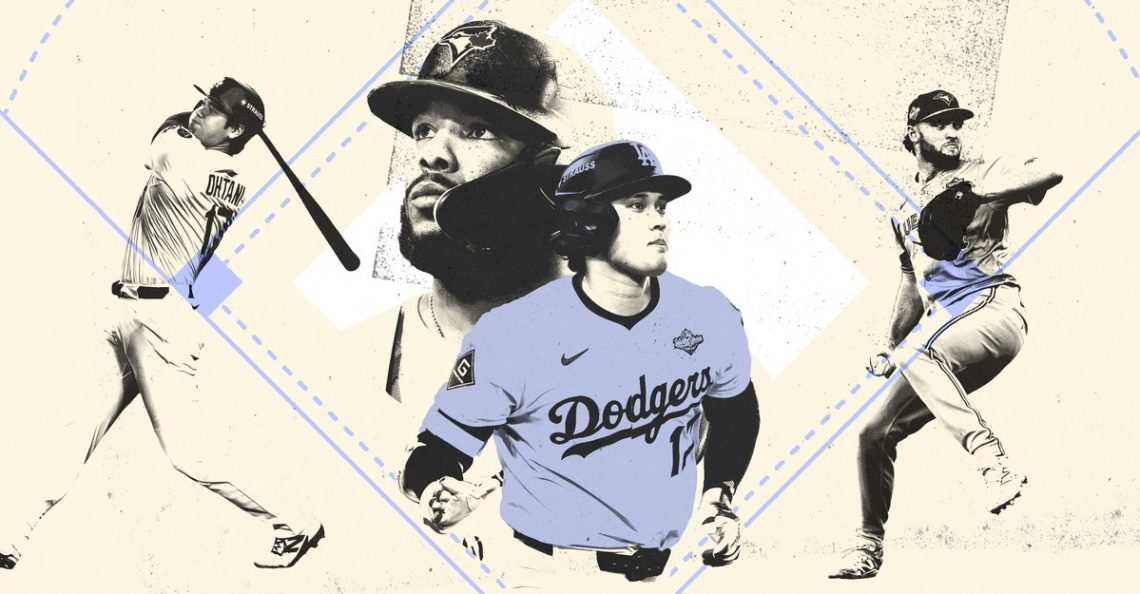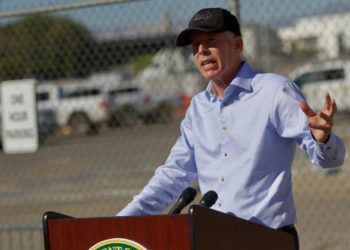Baseball, perhaps more than any other sport, competes with its own deep mythology. So many of its highlights are in black and white, and so many of its GOATs are ghosts, that the former national pastime is easily dismissed as past its prime. It isn’t. The 2025 postseason, which ended when the Los Angeles Dodgers beat the Toronto Blue Jays in the 11th inning of the seventh game of an ulcer-inducing World Series, stands with any in baseball history.
The early rounds of the postseason were enlivened by extraordinary feats from the game’s two biggest stars, but that was just baseball clearing its throat for the World Series, which earned its title—in English, Spanish, and Japanese; in the United States and Canada—as a genuine Fall Classic. Major League Baseball is 149 years old. The National League was founded a month before Alexander Graham Bell patented the telephone. And the game somehow still delivers the unexpected and the unforeseeable.
Game 3 of the World Series was a stone-cold thriller, with peaks of high drama and longueurs of exquisitely tense tedium. It started at 5:11 p.m. in Los Angeles and ended shortly before midnight, when the Dodgers’ first baseman Freddie Freeman finally hit a solo home run to the black void of the batter’s eye in center field. The home team earned a 6–5 win, a two-games-to-one series lead, and the chance for both teams to briefly rest the record 19 pitchers they collectively employed.
Tied for the longest game in the 121-year history of the World Series, at 18 innings, the outing will largely be remembered as the Dodgers’ Shohei Ohtani’s second magnum opus of the fall (more on his first later). He doubled twice and homered twice, the first time a player has had four extra-base hits in a single World Series game since 1906. Naturally, he was walked his next five times up—all but once intentionally—meaning Ohtani reached base nine times in nine plate appearances, a postseason record by three.
When Ohtani said afterward that he wanted to go to sleep as soon as possible, to rest up for Game 4, he spoke for all of us. Of course, we just had to watch. Ohtani was scheduled to pitch. Ohtani is the sole occupant of that sliver of Venn diagram where the game’s best pitchers and the game’s best hitters overlap. If Tom Brady routinely sacked quarterbacks when he wasn’t playing quarterback himself, you’d have something approaching Ohtani. But for now, there is only him.
Seventeen hours later, when Ohtani faced the Blue Jays’ own hitting powerhouse, Vladimir Guerrero Jr., in the first inning of Game 4, an unstoppable force moved an immoveable object: Ohtani struck out Guerrero. In the third inning, an immoveable object stopped an unstoppable force: Guerrero homered off Ohtani, driving a sweeper into the left-field seats.
The Jays won that game, tying the series at two games each, and won the next night thanks to another historic performance, this one by the Jays’ rookie right-hander, Trey Yesavage. He struck out 12 Dodgers, the most Ks by a rookie in World Series history, breaking the 76-year-old record of Don Newcombe, who did it for the Dodgers when they played in Brooklyn.
Growing up in Boyertown, Pennsylvania, Yesavage built and maintained a pitcher’s mound in his backyard the way other kids might tinker with cars. Both are a means of escape. Since April, Yesavage has risen from Class A to High A, to Double-A, to Triple-A, to the Blue Jays, an ascension so rapid, it would give most players the bends. Yesavage has now pitched more playoff games in the big leagues than he has regular-season games. At 22, he became the youngest starting pitcher in the World Series since 21-year-old Brooklyn Dodger Ralph Branca in 1947, which was the last World Series attended by Babe Ruth, who died the following August.
Yesavage was not the only pitcher who drew historic comparisons in this series. The Dodgers’ Yoshinobu Yamamoto pitched a complete game to beat the Blue Jays in Game 2, becoming the first pitcher in 24 years—since the Diamondbacks’ Curt Schilling in 2001—to go the distance twice in a row in the same postseason. And that was mere prologue. He threw six innings in Game 6, and two and two-thirds more out of the bullpen the next night—the most of any Dodger pitcher in Game 7. He was the winning pitcher in both of those games. In an era when pitchers are held to a strict pitch count, many exiting in the fifth inning to a cavalcade of relief specialists, Yamamoto might be the last living descendant of Cy Young, who threw 749 complete games and became, with the award that bears his name, synonymous with pitching excellence.
There is no historical comparison for Ohtani, who put the Dodgers in the World Series by striking out 10 Brewers in six innings of shutout baseball on October 17, while also hitting three home runs. When another Dodgers slugger, Wally Moon, was hitting bombs in the 1960s, they were called “moon shots.” But Ohtani’s really did appear to be lunar-bound. You half-expected them to sail past the Southern California moon in silhouette, like Elliott and E.T. on a bicycle. When he was pulled as a pitcher, to a standing ovation, Ohtani left the mound to the sounds of the Dodger Stadium organist Dieter Ruehle playing “Jesus Christ Superstar.” The hyperbole is irresistible.
And yet for a long time this fall the game’s hottest slugger wasn’t Ohtani, nor even the Yankees right fielder Aaron Judge, though he is the other all-time baseball god who played at the peak of his powers this October. During Game 3 of the American League Division Series, Judge hit a game-tying, three-run rocket to stave off his team’s elimination by the Blue Jays. The ball pinged the left-field foul pole at Yankee Stadium as if it were the tine of a tuning fork, causing the Bronx to vibrate. It was a highlight that stands with any other in the lore of that baseball borough. Judge had a torrid 1.273 on-base-plus-slugging percentage in his abbreviated postseason, but was eclipsed in October by Guerrero, whose OPS hovered around 1.300 in the playoffs after he endured a dismal September. Guerrero was the biggest reason the Blue Jays made it to the World Series.
Everyone, it seemed, was watching this year’s baseball postseason. “They lost,” Pope Leo XIV told a visitor to the Vatican who shouted “Go Cubs!” at him in October. The pontiff—the world’s most famous White Sox fan—was evidently following the baseball playoffs (in which, yes, the Cubs lost to the Brewers in the National League Division Series). Perhaps that’s not surprising for a 70-year-old man from Chicago, given baseball’s famously aging TV demographic. But with Sydney Sweeney at Dodger Stadium, and Drake at the Blue Jays’s Rogers Centre, and the Mariners slugger Cal “Big Dumper” Raleigh signing a toilet seat to a chorus of adolescent cheering at the Little League World Series, baseball was prominent in pop culture, not just pope culture. Ratings in the U.S. and Canada for Games 1 and 2 of the World Series were up nearly 25 percent over last year. Major League Baseball is not dead yet.
MLB has tried in recent years to make the game more exciting. The pitch clock has sped the game’s geriatric pace. Larger bases have promoted stealing. An endless array of alternate uniforms ensures the viewer is never quite certain which team is which. Next year, we will welcome our new robotic overlord, the automated ump, with each team getting two challenges per game of the human umpire’s ball and strike calls. In spite of all that, we have this month witnessed baseball from another era, or perhaps from every era. Fox went to commercial in Game 1 of the World Series playing Portugal the Man’s “Feel It Still,” the bit that goes: “I been feeling it since 1966 now.” That year saw the final October for Sandy Koufax, when his Dodgers tried and failed to repeat as champs.
Once again, this time around, the Dodgers were trying to repeat. Koufax, now 89 years old, was in the stands for Game 3, when his spiritual descendant, the left-handed Dodger-for-life Clayton Kershaw, who was in his final season, took the mound. Kershaw, age 37, emerged from the bullpen in the 12th inning with the bases loaded and two outs, and got Nathan Lukes to ground out as Koufax stood and applauded. The Blue Jays’ own lion in winter, the 41-year-old Max Scherzer, started Game 3. It’s getting him to stop pitching that remains a challenge. “I thought he was going to kill me,” John Schneider, the Jays’ manager, said after trying to remove “Mad Max” from a playoff game against Seattle.
Scherzer started Game 7 of the World Series against Ohtani. Both men will have bronze bas-relief plaques in Cooperstown, but only Ohtani will have a 2025 World Series ring. The game-tying home run in the ninth inning by the Dodgers’ second baseman Miguel Rojas, and the game-winning home run in the 11th by the catcher Will Smith, were distant echoes of Kirk Gibson’s game-winner for the Dodgers in the 1988 series. Yamamoto was named the World Series MVP, as Koufax was 60 years ago. Guerrero ended the game, and his season, stranded on third base—90 feet from fulfilling his ambition of giving a World Series ring to his father, who has a Hall of Fame plaque but no ring to show for his 16 years in the big leagues.
In these ways, baseball’s past and present join hands, as clock hands do at midnight, or palms do in prayer. Late nights and anxious supplications. This fall, and this Fall Classic, were full of them.
*Lead Illustration Sources: Vaughn Ridley / Getty; Mary DeCicco / MLB Photos / Getty; Daniel Shirey / MLB Photos / Getty.
The post The Best Postseason in Baseball History? appeared first on The Atlantic.




